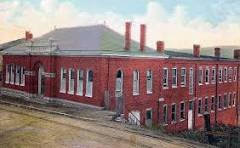The poplar (aka yellow poplar, tuliptree) can grow to be the tallest of West Virginia’s hardwoods and is commercially important for lumber and pulp wood. An unusually majestic poplar was sighted on the Greenbrier River during the Civil War, and according to The Greenbrier Independent it was to be used as a canoe to transport supplies on the river for camped soldiers. Because the poplar is relatively light weight, straight, and easily hewn it was commonly used to make canoes.
For some unknown reason, this particular tree was spared until 1875 when it was cut by J. C. Gwinn into three logs. The tree was 60 inches in diameter, and the main trunk was 50 feet long. The first two logs were 12 feet long, the second two were 9 feet, and the remaining log was 10 feet. Three of the logs were floated down river to a mill where they were sawn into lumber and yielded 2,700 ft. of merchantable lumber. One log was sawn for porch columns that were shipped to Richmond, Virginia.
Shown in the circa 1908 photograph is a freshly-cut poplar from Webster County with logger John Hinkle.
Photo courtesy of the West Virginia University West Virginia & Regional History Center.
Source: The Greenbrier Independent.


